Outcomes from current standard composting processes can range from high quality composts (rich in carbon, nitrogen, and healthy biota) to simple organic material (rich in carbon but low in nitrogen and biota) to noxious, harmful failures, depending on the input materials, weather conditions, and management practices used. Even following certified organic regulations is no guarantee that quality compost is being produced.
According to NOP guidelines, compost temperatures must remain between 131ºF and 170ºF for 15 days, while being turned a minimum of 5 times. After this heating period, the compost should (in theory) cool down, but this is often not the case. Observations have shown that these practices commonly generate temperatures that remain above 145ºF for months, creating an inhospitable environment for most of the beneficial organisms in the pile. When such piles remain hot for long periods, the oxygen content of the pile becomes limited, killing beneficial fungi, protozoa, and nematodes that are vital to cycle and retain key crop nutrients within the pile.
With some changes to common compost techniques, farmers, waste managers, and compost producers can create high quality compost that provides excellent biotic populations, nutrient retention, and nutrient cycling, which is best able to support healthy, vigorous crops when applied to the field. In fact, when the starting materials for a compost pile are balanced and properly monitored, compost can be produced with less labor and energy cost, as well as a faster turnaround time.
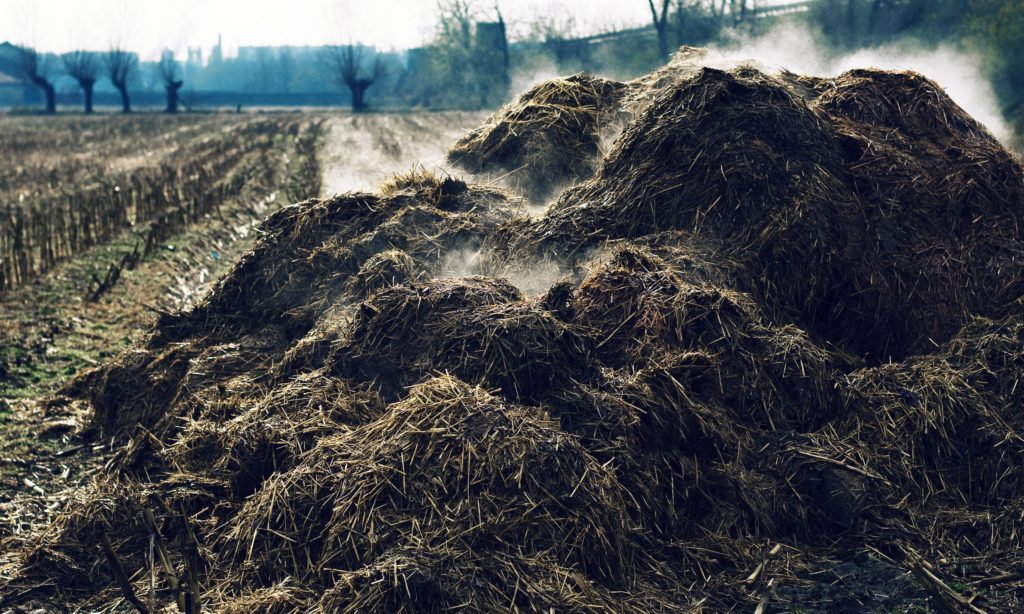
The Benefits of Good Compost
Composting is oxidative decomposition of a mix of organic materials. Oxidative means “with oxygen.” Thermal composting, specifically, is a hot, fast process of aerobic decomposition of a mix of organic materials, generating temperatures above 131ºF to 165ºF, requiring turning to maintain aerobic conditions in the pile.
Foul odors such as ammonia or hydrogen sulfate (rotten eggs) are typically produced when compost goes anaerobic (“without oxygen”) and is turned into putrefied organic matter. Anaerobic organisms, present as dormant stages when the material was aerobic, become active in the low oxygen atmosphere. Once anaerobic, the material cannot be called compost, as it no longer meets the definition of compost.
Small packages, big benefits
The organisms in properly made, aerobic compost can:
• Eliminate plant and human pathogens
• Retain nutrients and prevent greenhouse gases
• Decompose toxins and chemicals
• Bind heavy metals
• Divert waste from landfills, turning it into a useful product
• Reduce odors
• Suppress weeds
• Increase water holding capacity
• Prevent erosion
• Restore a healthy soil food web
• Build soil structure
• Increase soil organic matter
• Prevent nutrient leaching
• Stimulate root growth
• Fix nitrogen
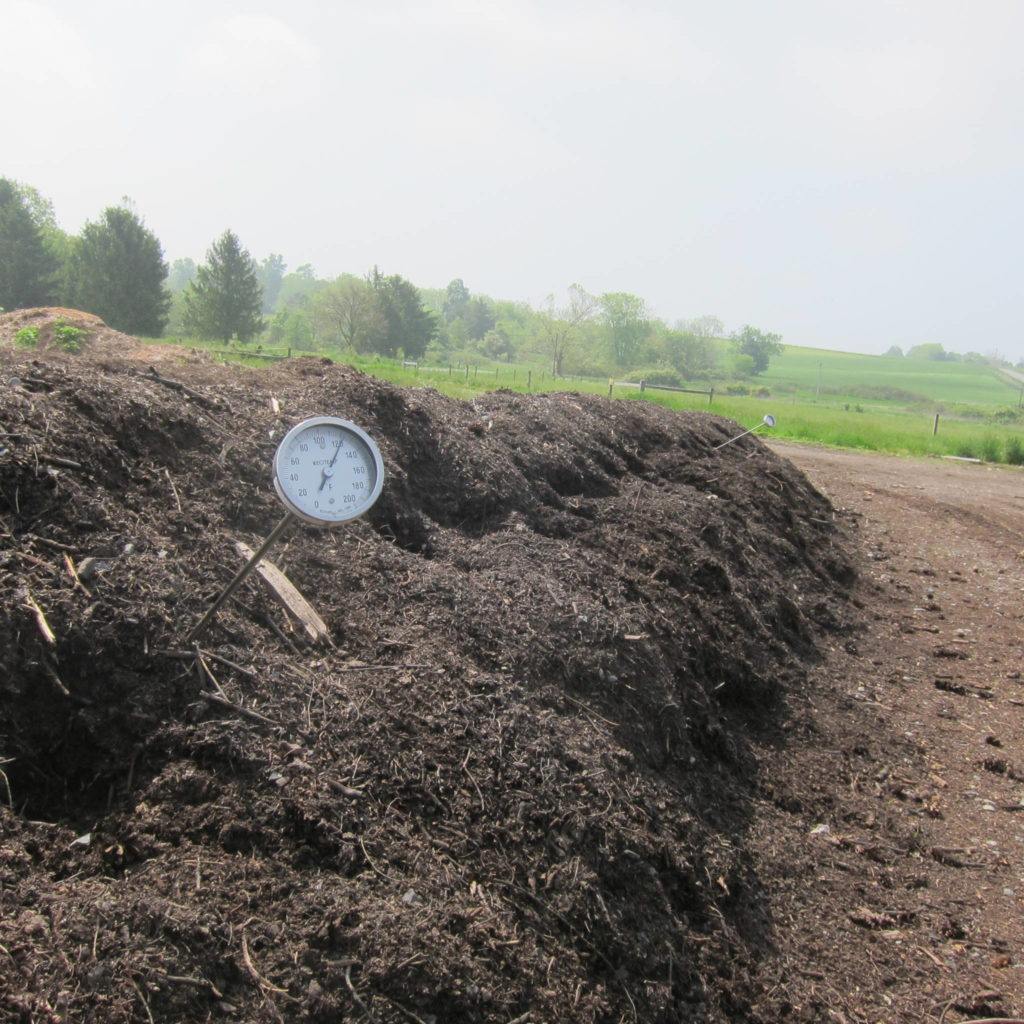
Better Compost with Less Work
With support from USDA’s Conservation Innovation Grant (CIG) Program, Rodale Institute has begun the process of demonstrating that when the starting materials for a compost pile are balanced properly and monitored, time and energy can be minimized as compared to less-controlled composting methods.
National Organic Program guidelines currently require compost to be turned a minimum of five times within a 15-day period,
during which time temperature must be maintained between 131ºF and 170ºF. While the guidelines act as a safety net to ensure that pathogens are destroyed, they do not guarantee that a diversity of beneficial organisms will be produced in the end product. The assumption is that temperatures will remain above 130ºF long enough to kill pathogens and weed seeds and give you a finished product in the end. But with very little detail on when and how to turn within that 15-day period, composters can end up turning their pile too often or not enough. Turning too often can interrupt the heating-up process, causing temperatures to drop. Not turning enough can lead to an overheated pile, depleting the oxygen and making the pile anaerobic.
This is a critical issue that may leave composters feeling uncertain. By observing biological indicators of compost activity in a pile, it can be turned at the exact moment that the organisms need more air, leading to a much more efficient system that saves time, energy and money, and yields a higher quality product in less time.
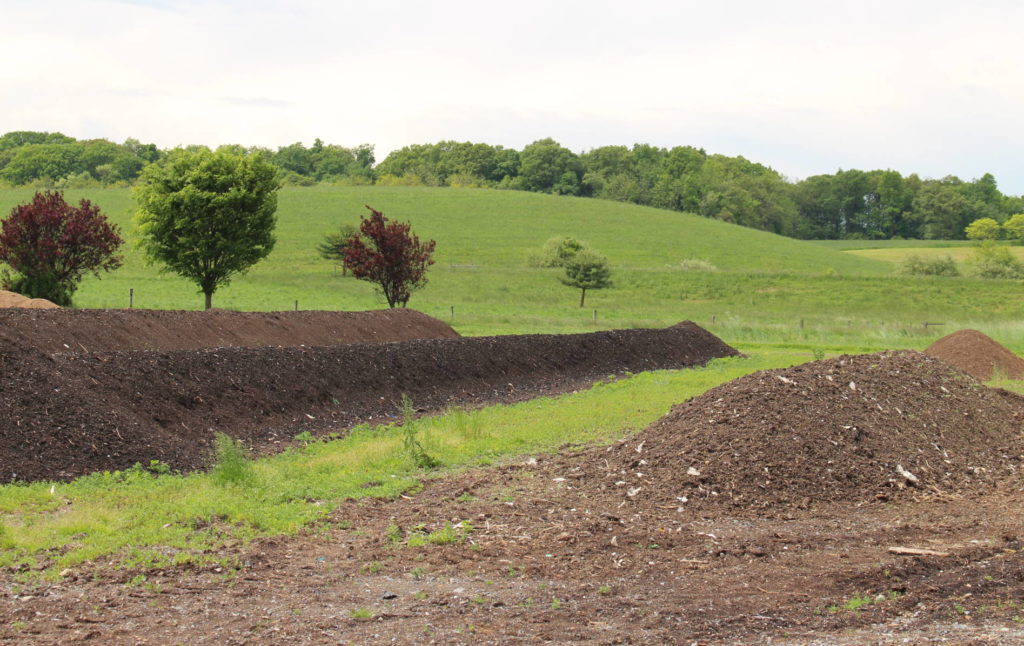
Recipes for Maintaining Aerobic Conditions
The importance of maintaining aerobic conditions while composting and the need for a diversity of aerobic organisms has been undervalued by some composters. But, the benefits provided by these organisms, as demonstrated in Ingham et al. 1986, and more recently by Cheeke, et al., 2006, cannot occur if the organisms are not present. It is necessary to understand that a diverse set of soil organisms is important for making good compost. The organisms also require food to sustain them so they can perform their beneficial functions. Thus, compost by necessity requires both organisms and organic matter maintained in an aerobic condition.
For more information on the various beneficial soil organisms and their roles, see the NRCS Soil Biology Primer.

The general recipe to follow depends on how fast the finished product is acquired and how much effort per day can be given to the
production of the compost. Commercial operators will expend intensive amounts of effort to produce fast-turn-around compost, especially if clients understand that compost containing extremely beneficial organisms is worth additional money. Homeowners who want to deal with waste materials without obnoxious smells and without attracting rodents, but who do not want to expend intensive effort, will use the slower-composting recipes.
Checking Moisture
1. Dig into your pile at least a foot or until it gets too hot to touch.
2. Pick up a handful of compost and squeeze hard.
3. If you feel liquid between your fingers, or if one or two drops of water come out, the compost is in the ideal moisture range, between 40% and 50%.
Table 1: Composting management approaches
All starting material must be clean from contamination, moisture should be maintained at 40% to 50% (free water per fresh weight) and turning should be performed when any indicator of anaerobic conditions are detected.

Definitions for Table 1.
Intensive Care: Temperature and moisture must be carefully monitored to make certain that the pile does not reach anaerobic conditions. Turning may be required two to three times a day early in the composting process, but because of the rapid use of simple, easy-to-use foods, the temperature will drop rapidly to ambient conditions around day 21. If care is not constant and intense, the pile will become anaerobic and remain at high temperatures, only returning to ambient conditions after months.
Moderate Care: Temperature and moisture need to be monitored daily for the 15 days after starting the pile while the temperatures are above 131ºF. If care is taken with the recipe, turning should only be on the first day that the temperature reaches 160ºF (e.g., day 2), 24 hours after that (day 3), another 24 to 48 hours later (day 4 or 5), then 48 to 72 hours later (day 6, 7, or 8), and then a final turn three to five days later (day 9 to 13). Temperatures should fall off rapidly to ambient levels around days 42 to 56.
Minimal Care: Temperature and moisture need to be monitored daily for 10 to 15 days after starting the pile while the temperatures are above 131ºF. If care is taken with the recipe, turning should only be necessary on the first day the temperature reaches 160ºF (e.g., day 6), then perhaps a second turn 24 to 48 hours after that (day 7 or 8). Temperatures should then fall off slowly to ambient levels around day 60 to 90.
NOTE: This system of turning will not meet the NOP standard for use on organic farms.
Biological: A mix of highly diverse sets of bacteria, fungi, protozoa, nematodes and microarthropods, preferably indigenous to the area being farmed, added into the compost in an active or close-to-active condition. These organisms should be in high numbers and highly active so that they will initiate decomposition processes and speed composting.
High N: Plant material high in nitrogen concentration, typically a carbon to nitrogen ratio (C:N) of 10:1 to 20:1. Materials such as legumes with adequate nodulation of the roots, fresh manure, seed germ or first-cut grass.
Green: Plant material that is cut green, while significant photosynthesis is occurring so that high levels of simple sugars, proteins and carbohydrates are in high concentration; typically a C:N of 30:1. Materials such as food waste, end-of-season crop residues, and decomposed tree leaves.
Woody: Plant material harvested after the plant has removed simple, easy-to-use materials, leaving high concentrations of cellulose and lignin; typically C:N ratios 100:1 or greater. Materials such as sawdust, wood chips, fresh fall leaves, pine needles, straw.
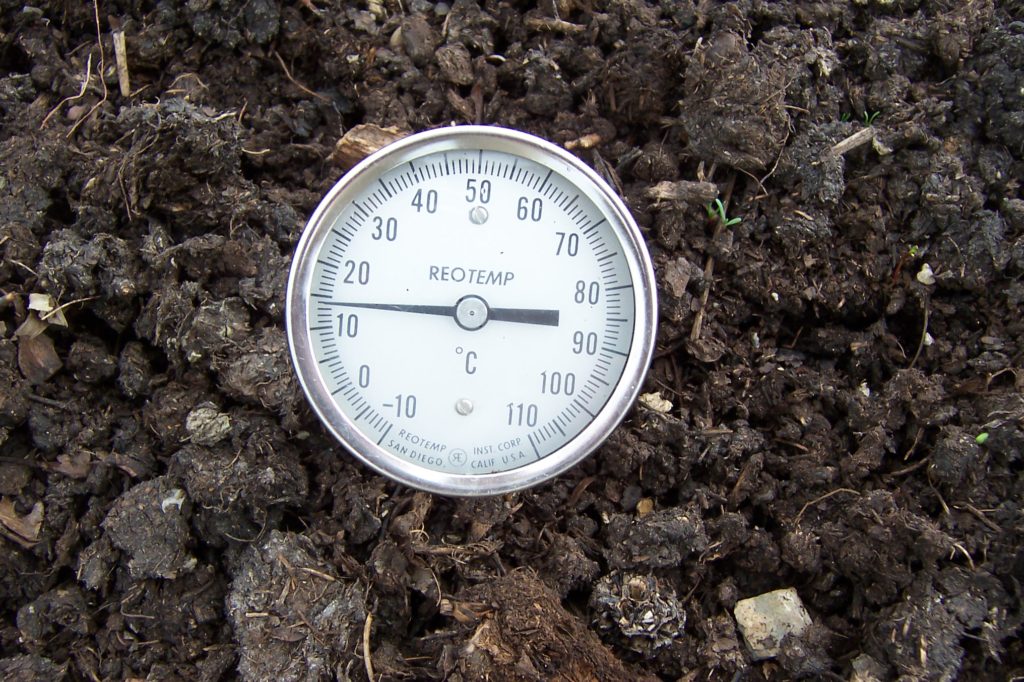
When is it finished?
The thermal composting process is finished when temperatures have returned to ambient levels after having been above 131ºF (55ºC) for a full 15 days, during which time the pile is turned 5 times. Compost that is 5 to 10 degrees above ambient cannot be counted as being finished and can actually be detrimental to plants. When bacteria and fungi are still growing fast enough to increase temperature in the pile, even by 5 to 10 degrees over ambient, they are sequestering nutrients and holding them in their bodies rapidly enough that plants can be harmed, and possibly die, as a result of the lack of available nutrients.
Notes on Food Waste and Animal Manure
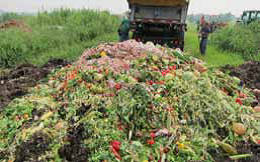
In all the recommended recipes, food waste can be used if two important factors are considered. First, the food waste should not be contaminated with plastics, metals such as utensils, cans, or lids, or other non-compostable materials. “Compostable” utensils should not be allowed as they do not decompose in outdoor windrow compost systems.
Before agreeing to take food waste, ensure that the agreement includes the right to refuse delivery on-the-spot based on specific criteria. Protocols should include the inspection of each load before the load is dumped. If contamination issues are present and detected before dumping or during the dumping process, the load should not be accepted. As part of the quality assurance protocols, a clause in any tipping agreement should include language that passes on the cost of removing any contamination back to the trucking company or waste generator.
The second factor to consider with food waste is variability in the amount of liquid in the load. Extremely juicy food waste requires an adequate amount of dry, wide C:N ratio material (woody) and high nitrogen containing material (hi N) to absorb the liquid. The bed of dry material must be capable of absorbing the moisture in the food waste to prevent any runoff.
80 percent of the weight of whole fruits and vegetables is water. During the decomposition process, this water can cause waterlogging of the pile, leading to anaerobic, putrid, smelly conditions. Thus, a compost pile that appears to be 50% moisture after a day or two of absorbing moisture can be dripping and oozing moisture in a day or two as the fruits and vegetables release their internal water. Since oxygen cannot move through water rapidly, the pile will quickly become anaerobic with all the problems that pertain to anaerobic conditions.
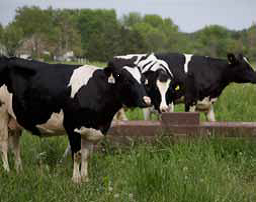
Animal waste needs to be reasonably fresh and should not be extremely anaerobic. If this is the case, the material may have lost a
great deal of the high nitrogen component critical in encouraging the bacteria and fungi to grow rapidly, thus reducing its potential to heat the pile to the required temperatures. The pile should not reach temperatures above 160ºF, however, as problems with oxygen exchange will likely lead to anaerobic conditions in the pile. If the percentage of high nitrogen material is too large in the pile, the pile may heat so rapidly that oxygen falls to low levels and anaerobic bacteria and yeasts produce alcohol–a strictly anaerobic phenomena. At temperatures near 180ºF, spontaneous combustion is likely to occur.
The use of animal wastes such as manure in compost production may result in human health concerns, as these materials can contain human pathogens that can cause disease. The potential presence of these disease-causing organisms in manures and in food wastes means that care must be taken when they are handled. Temperatures above 131ºF must be reached for a full three days to kill disease organisms, along with pests, parasites, and weed seeds. Since the outside edges of the pile will most likely not reach the required temperature of 131ºF, it is critical to turn the pile and physically move the organic materials from the outer edges towards the inside center part of the pile where temperatures remain hot enough for sufficient amounts of time.
Troubleshooting Anaerobic Conditions
Variability in the quality of high nitrogen materials, green, and woody components can be difficult for new composters to manage. Thus, there must be mid-course indicators that can be used to warn of impending problems. These indicators were developed during the study involving food waste as a replacement for the green plant materials usually used in thermal compost.
Table 2: Indicators Used To Detect Anaerobic Conditions.
What measurement is used, what indicates a problem, and how to fix that problem.

This material is based upon work supported by Natural Resources Conservation Service, U.S. Department of Agriculture, under Grant Agreement Number 69-2D37-11-499. Any opinions, findings, conclusions, or recommendations expressed in this publication are those of the author(s) and do not necessarily reflect the view of the U.S. Department of Agriculture.
Search our research section for information on compost, soil health and more!
For more updates on Rodale Institute’s research and programming, follow us on Facebook, Instagram, and Twitter.
